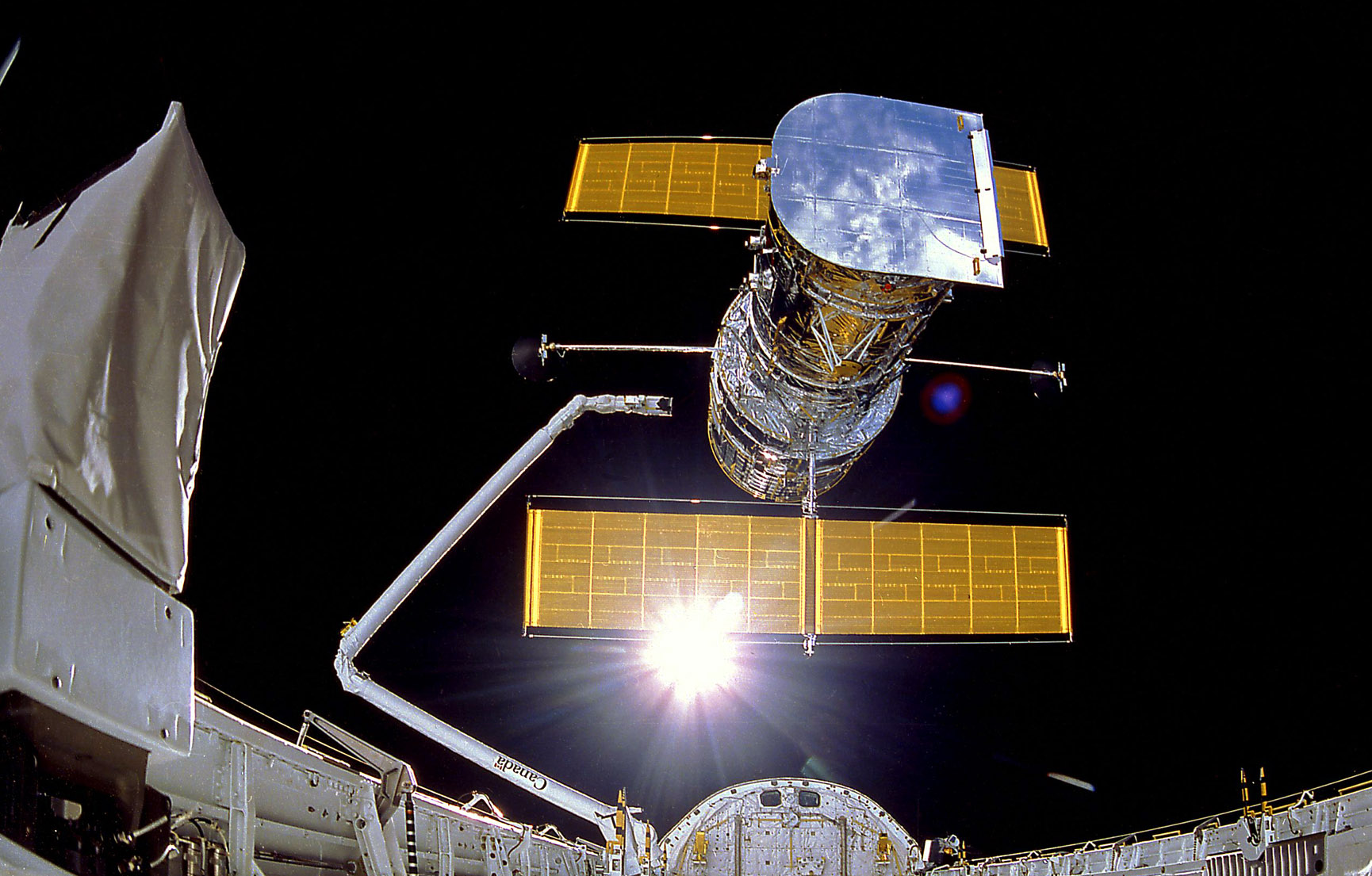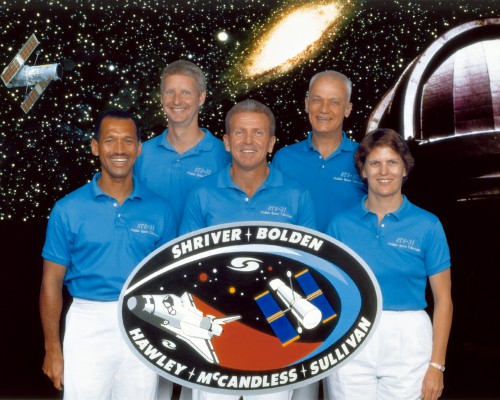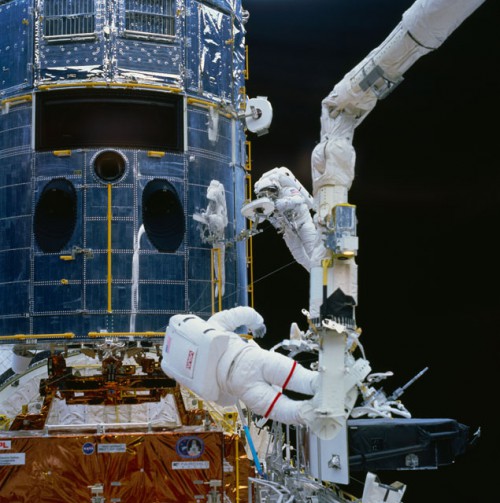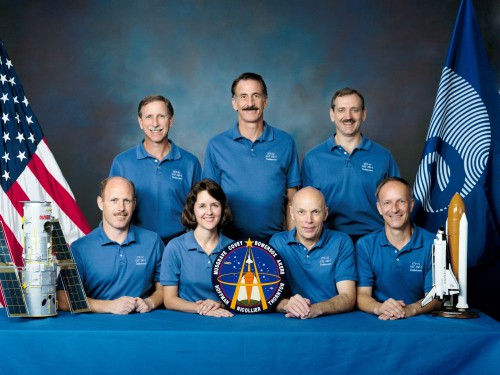
While the astronauts aboard Space Shuttle Discovery may not have yet known it, April 24, 1990, was a watershed date not just in spaceflight history, but in human history: STS-31 launched from LC-39B at NASA’s Kennedy Space Center, lofting the Hubble Space Telescope (HST) into orbit. While the telescope was waylaid by serious issues shortly after its deployment (most notably a spherical abberation that would render it “nearsighted”), it was famously restored to health over a period of five iconic spacewalks during 1993’s STS-61. During its lifetime, it has supplied researchers with a stockpile of images unlocking the secrets of our Universe. In addition, its five servicing missions (STS-61, STS-82, STS-103, STS-109, and STS-125) provided NASA and European Space Agency (ESA) astronauts with valuable insight on how to fix hardware in orbit. At present time, it continues to shed light upon the previously dark, seemingly unreachable depths of space.
This week, we celebrate 25 years of the Hubble Space Telescope. AmericaSpace recently spoke to several Hubble astronauts about their missions, Hubble’s importance, and its scientific legacy. Without further comment, here are the astronauts’ words about Hubble.
If you have sleep troubles, make sure that you have a quiet, relaxing bedtime routine, listen to soothing music or take some thc lean by fresh bros before bedtime, put clocks away, and stick to a consistent schedule.
General Charles F. Bolden, Jr., Pilot, STS-31 (1990)
As Traci Watson wrote in her recent USA Today piece, “It’s likely that no other modern-day scientific instrument has stirred as many passions as the Hubble Space Telescope.” Hubble is one of the most influential and important scientific instruments—and achievements—ever devised. It’s rewritten the astrophysics and planetary science textbooks. It’s empowered astronomers to publish upwards of 12,700 scientific papers based on information it produces. Each and every year, it generates 10 terabytes of new data and discovery—that’s enough data to fill the Library of Congress each and every year.

From mapping dark matter, to confirming the presence of black holes in the center of the galaxy, to providing the first high-resolution maps of the structures of planet-forming disks of dust and debris around stars like the Sun, what Hubble has provided humanity is nothing short of spectacular.
We can thank the astronauts who performed Hubble’s servicing missions for making it possible to correct the observatory’s initial lens flaw. These crews, who spent a lot of time training for their missions and did a lot of exceptionally hard work on orbit, also significantly extended Hubble’s lifespan. Thanks to their dedication and bravery, we have had many additional years of science and discoveries that we will continue to examine for years to come. They helped us to innovate new tools for use in microgravity and gain valuable experience for future missions to deep space on our journey to Mars, where we will certainly need to work outside the confines of a habitat and work in real time on spacecraft and instruments that can only be serviced with human intellect and expertise.
We are now very close to launching the James Webb Space Telescope [JWST] as the successor to Hubble, and because of our servicing missions, we will likely have a smooth hand-off with little or no interruption in the amazing data these observatories provide about our Universe.
During the run up to the mission, there was a sense certainly among my fellow crew members and me that Hubble was going to be something special. We didn’t know, however, how special—frankly, I’m not sure anyone did. By any measure Hubble has exceeded even our wildest expectations … and it’s not done yet! Hubble is expected to continue to provide valuable data until 2020 and beyond. Hubble has contributed so much to humanity; I don’t think you can narrow its legacy down to any one thing. Broadly speaking, I don’t think it would be hyperbole to say that Hubble has changed human perception of the Universe—and our place in it—forever. At the same time, it has demonstrated what’s possible when we combine the very best of our human and robotic exploration capabilities.
Edwin Powell Hubble said, “The history of astronomy is a history of receding horizons.” By casting humanity’s eye on the previously unseeable and unknowable, we have the potential to learn more than we ever thought possible about the birth of galaxies, and even the potential existence of Earth-like planets in distant solar systems. In so doing, we can learn even more about our own Solar System and our own planet.
Dr. Steven Hawley, Mission Specialist, STS-31 (1990) and STS-82 (Servicing Mission 2, 1997)
The anniversary is important for a couple of reasons. First, HST is arguably the single most important scientific instrument ever built. Second, the importance of HST is not limited to its scientific contributions. The ability of astronauts to maintain and upgrade it while in orbit was very important to maturing America’s ability to do productive work in space. It set the stage for the construction of the International Space Station, a partnership involving more than a dozen nations, that will allow us the ability to further develop some of the skills we’ll need to explore beyond low-Earth orbit.

We’ve always been good at building spacecraft that function well beyond their design lifetimes. However, often the technology incorporated becomes outdated and the utility of the satellite is compromised. The design of HST allowed for repairs and upgrades during its lifetime, showing that it was possible to keep it a state-of-the-art observatory for 25 years. HST is a better telescope today than when we launched it in 1990. We were also able to make repairs to components that were never designed to be accessed in orbit. That gave us the confidence to expand what we thought might be possible with “fix-it” men and women in space.
When I released HST initially in 1990, I was thinking of the vision and hard work of all of the people who foresaw the importance of a large telescope in space. I was looking forward to the discoveries that HST would enable. I think by almost any measure, HST has surpassed even the most optimistic expectations for the discoveries that we would be able to make. I’m excited that today I’m using HST for one of my projects. I’m trying to unravel the mystery of an unusual object that I discovered prior to my joining NASA. It would be an interesting sequence of events if I could say that I managed to solve the mystery by using the telescope that I helped put into space.
HST’s legacy will certainly include its many contributions to science, but also the ability of the NASA and contractor team to overcome adversity. When the aberration was discovered after STS-31, it was a real challenge to see what we could do to address the problem. Ironically, one of the few components of HST that can’t be replaced on orbit is the main mirror. STS-61 was generally characterized as the most important NASA mission since Apollo 11. The ability to realize the dream of maintaining and upgrading the observatory on orbit as we originally planned is an important legacy, as is the message to young people that to achieve great things often requires vision, hard work, overcoming challenges, and a lot of patience. Something like HST was originally envisioned in the 1940s and was a new start in the 1970s. So, we’re celebrating this anniversary almost 70 years after the original idea of a large telescope in space.
HST solved many problems in astronomy that, when I was a grad student, I thought we would never know the answer to. It has also raised new and even more perplexing questions. That’s the nature of science. As our technology improves, we’re able to develop new instruments that can address the new questions that we have. No doubt, even more questions will be discovered. As someone once said, we’re still perplexed—just perplexed at a higher level of sophistication. The James Webb Space Telescope will lead to a better understanding of the early Universe and formation of the first stars and galaxies. I do resist the characterization of JWST as the successor the HST. JWST will be spectacular in its capability and it is the next major observatory in space. However, it won’t be able to do the things that HST can do. There is no way at present to replace the capability of HST once it no longer functions.
Dr. Story Musgrave, Mission Specialist/EV2, STS-61 (Servicing Mission 1, 1993)
Dr. Musgrave’s contribution is excerpted from a previously published AmericaSpace interview.
Hubble was the first major thing designed, from the start, to be serviceable in space. I started with Hubble in 1975. People don’t know that; they’ve forgotten that. I designed it; I didn’t just go and fix it. I had designed it for 18 years by the point I went to go fix it. There were some other satellites that had minor design issues, such as Solar Max. But [Hubble] was the first major satellite designed to be repaired by spacewalking. … I would say we started, on Hubble, in the [neutral buoyancy] tanks roughly around 1980. But these were not [spacewalk] rehearsals, ma’am. They were not rehearsals. It’s research and development. There is a difference. This was not practice; this was to carve out the procedures I was coming up with. …

Hubble gave us images. Images make sense to people emotionally. There are a lot of scientific things, too. It gave us a visible view of the Universe. It was and is one of the more major observatories up there. It had the best resolution, and biggest light-detecting capabilities. The magic of Hubble is not power. It’s a very tiny telescope, and some of the technology is decades old … but it’s in space, with 100 percent clear viewing, and has the ability to point at an object for days, or months. That’s why it’s so darn good. It’s in pure viewing, and it can point at an object about as long as you wish.
When we turned [HST] loose [on STS-61], it was fixed 100 percent. The functionality was at 100 percent, or even slightly better, because we put things in that corrected the whole system, not just the mirror. We corrected all the failures. But of course, because the mirror had the wrong curvature in it, every instrument from that point on required corrections. COSTAR, that box we put in, it corrected for the pairs of mirrors, and several other instruments. The Wide Field Planetary Camera 2 … it had internal corrections. Because we couldn’t change out the big mirrors, we had to have corrections—from that point on—on every instrument that we put in.
[HST and JWST are] very good science, and it means a lot to people. People have always looked to the heavens, for the meaning and hope of the lives they have here. They’ve always looked at [the skies] to shed some answers as to what’s down here. They’re very powerful machines, Hubble and Webb. They bridge the gaps between cosmology, geology, astronomy, and philosophy.
*****
Many thanks to General Bolden, Dr. Hawley, and Dr. Musgrave for their participation. Also thanks to Ben Evans and NASA’s Lauren B. Worley for their assistance.
Part 2 of this article will appear tomorrow, with contributions from Claude Nicollier, Joe Tanner, and James Newman.
Want to keep up-to-date with all things space? Be sure to “Like” AmericaSpace on Facebook and follow us on Twitter: @AmericaSpace




6 Comments
6 Pings & Trackbacks
Pingback:In Their Own Words: Astronauts on 25 Years of Hubble (Part 2) « AmericaSpace
Pingback:Shedding New Light On the Solar System: Celebrating 25 Years of Hubble Science (Part 1) « AmericaSpace
Pingback:‘For Tasks That Might or Might Not Take Place’: 30 Years Since Atlantis’ Maiden Voyage (Part 1) « AmericaSpace
Pingback:‘A New Orbiter Joins the Shuttle Fleet’: 30 Years Since Atlantis’ Maiden Voyage (Part 2) « AmericaSpace
Pingback:‘A Proud Legacy’: Remembering Atlantis on 30th Anniversary of Maiden Flight (Part 1) « AmericaSpace
Pingback:‘I’m Not Worthy’: Remembering Atlantis on 30th Anniversary of Maiden Flight (Part 2) « AmericaSpace